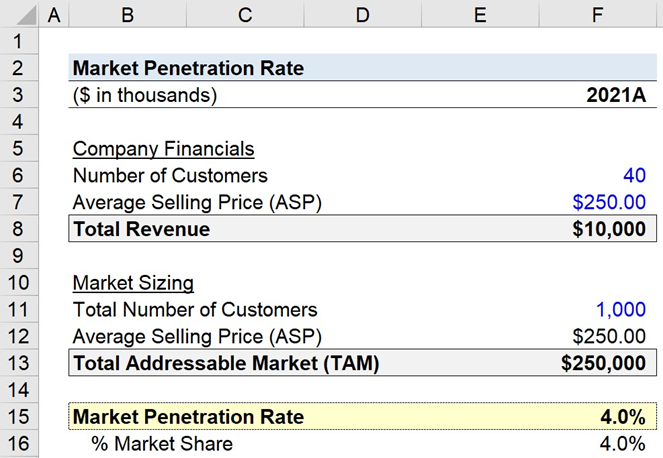Market penetration rate often gives an idea about how a product is doing in the market- whether it’s blooming or otherwise. It’s a vital measure for comprehending the market prospects of any business and its performance trajectory, which when combined with other aspects such as economic conditions, competition, and consumer behavior allows one to take informed decisions and necessary steps to save losses or embrace success firmly. In this blog post, you will get educated on what precisely is Market Penetration Rate. How it is calculated? And why should you care about maximizing your products’ Market Penetration Rate? So without further ado let us dive into understanding everything there’s to know about calculating your own Market Penetration Rate effectively!
What is Market Penetration Rate?
Market Penetration Rate (MPR) is a measure of how successful a product or service is in penetrating the target market. It measures the percentage of potential customers that have adopted the product or service and uses this to identify how well it is being accepted. Market penetration rate helps companies understand their level of success when launching new products and services, as well as how to improve them.
It also provides insight into how saturated the market is with similar products and services, and which ones have the most potential for growth. By understanding these trends, companies can tailor their marketing strategies to maximize sales and profitability.
The higher a product’s MPR, the more successful it has been in penetrating its target market. Companies can use MPR to track changes in consumer preferences over time, gauge the effectiveness of new product launches, and assess where their competitors are in terms of market share. This can help them identify areas for improvement or growth opportunities.
Why Is It Important For Startups to track the Market Penetration Rate?
Following are the reasons why tracking the Market Penetration Rate is important for Startups:
1. Gain a Deeper Understanding of the Market:
Tracking the market penetration rate can help startups gain a deeper understanding of their target customers and how well they are responding to their products or service. This data helps them identify potential areas for improvement, new markets to tap into, and even changes that need to be made in order to better address the needs of the market.
2. Monitor Competition:
Tracking the market penetration rate can help startups keep tabs on their competition. This information can provide valuable insights into their opponent’s strategy and how they are performing in comparison to the startup itself. Knowing what their competitors are doing, helps startups create a more effective business strategy that will enable them to stay one step ahead of the competition.
3. Identify Growth Opportunities:
Tracking the market penetration rate helps startups see where they need to focus their efforts in order to increase sales and keep up with current trends in the market. This data can provide valuable insights into growth opportunities that may have been previously overlooked, enabling startups to capitalize on them and maximize their potential.
4. Drive Efficiency:
Market penetration rate tracking helps startups evaluate how their product or service is performing in relation to different segments of the market, allowing them to identify any bottlenecks that may be holding back sales and efficiency. This information can help optimize their product or service for maximum effect and ensure they are getting the most from their efforts.
Overall, tracking the market penetration rate is important for startups as it provides them with valuable insights into the performance of their product or service, enabling them to make informed decisions that will result in sustained growth and success. It also allows them to identify opportunities for improvement and stay ahead of their competition by keeping tabs on what they are doing.
How To Calculate the Market Penetration Rate?
Here is the formula to calculate the Market Penetration Rate:

Suppose a company has a market share of 10% in a certain product category and the total available market for that product category is 100 million people.
To calculate the Market Penetration Rate, we would plug these numbers into the formula like this: Market Penetration Rate = (10% / 100 million) x 100= 0.001 x 100= 0.1%Therefore, the Market Penetration Rate for this company is 0.1%.
This means that the company has a market penetration rate of only 0.1%, meaning it captures just 1 out of every 1000 potential customers in the market.
What factors affect the Market Penetration Rate?
The following factors affect the Market Penetration Rate:
Competition:
The presence of competitors, their pricing and product offerings, and the marketing strategies they use will all affect a company’s ability to penetrate the market.-
Distribution channels:
Effective distribution channels are essential for increasing penetration in any given market. Companies must have access to the right channels in order to capture customer attention and revenue from those markets.
Brand recognition:
A strong brand presence in the market will help increase market penetration. Customers are more likely to purchase products from a recognizable and trusted brand, so it is important for companies to invest in building their reputation and visibility.
Product innovation:
Companies must constantly innovate and improve their product offerings in order to stay ahead of competitors and capture the attention of new customers. –
Pricing:
Setting the right price point is essential for market penetration. Companies should assess their target customer base and determine what price points make sense for that audience in order to maximize revenues.
Market trends:
Understanding the current trends in a particular market is essential for maximizing market penetration. This can include understanding customer preferences, product innovations and pricing strategies of competitors. By keeping up with these trends, companies can better position their products to gain a greater share of the market.
Marketing Strategies:
A company’s marketing strategies should be tailored to the market they are trying to penetrate in order to maximize its impact. This means understanding the target customer, the competitive landscape, and leveraging appropriate marketing channels to reach those customers. Strategies such as influencer marketing, content marketing, and paid advertising can all be used to increase market penetration.
By taking time to assess these factors and develop an effective strategy for each one, companies can maximize their market penetration rate and further grow their business.
What is a good Market Penetration Rate?
There is no single answer to this question as it depends on the specific context and industry. Generally, a market penetration rate of 10-20% is considered good for most companies. However, some industries require higher rates of penetration due to their competitive nature and the high cost of entry.
Companies that have successfully penetrated a market may have done so at rates of 30-50%, depending on the complexity and size of the market. Additionally, companies that have successfully gained a foothold in an industry may also have achieved higher levels of penetration as they are better positioned to take advantage of existing customer demand.
Ultimately, the determination of what is considered a good market penetration rate will depend on the company’s objectives and the industry in which it operates.
Quotes about Market Penetration Rate
“A market penetration rate is a measure of how established a product or service is in a given market. A higher market penetration rate indicates that more customers have adopted the product or service and it has become widely accepted.” – Steve Jobs
“If you can increase your market penetration, you’re on the right track to success. A higher market penetration rate means that your product or service is gaining more customers and has become a popular choice in the industry.” – Mark Zuckerberg
“It’s important to keep an eye on your market penetration rate at all times. If it’s low, you may need to adjust your marketing strategy to attract more customers. If it’s high, you can use this data to inform decisions about how to continue expanding your customer base.”– Jeff Bezos
What are examples of Market Penetration Rates?
Assuming a company ended their 2021 fiscal year with 40,000 customers and an average selling price (ASP) of $250.00, the total revenue would be $10 million. Meanwhile, our company’s target market is estimated to comprise 1 million potential customers and the same ASP assumption is kept constant. This results in a total addressable market (TAM) of $250 million.
To calculate the market penetration rate, we divide our company’s number of customers by the total attainable customers in the market, resulting in a 4.0% rate. The calculated market share is then also 4.0%, given the same simplified ASP assumption for all competitors.
In the real world, however, the market share is not always equal to the market penetration rate because competitors may price their products and services differently.

EXAMPLE 2:
A smartphone company recently released their brand new android phone, featuring a strong processor, 16GB of RAM, 128GB of storage and a custom-tailored personal voice assistant in English. Their target audience was 25,000 people but only 10,000 purchased the product. Six months after launch they decided to calculate its penetration rate:
Penetration Rate = (Quantity of consumers/Target group size) *100
= (10000/25000) *100
= 40%
The company realized that the penetration rate of 40% was only average, so to increase it they partnered with a reputed electronics brand to offer customers 20% off on earplugs with every purchase. This increased their client base by an additional 20000, raising the penetration rate to 80%:
Penetration Rate = (20000/25000) *100
= 80%.
This example shows how a strategic approach to penetration can raise the rate by 40%, making it an effective marketing tool.
Tips to improve the market Penetration Rate
Following strategies can help to improve the Market Penetration Rate:
1. Offer attractive discounts and deals:
Discounts and deals are effective incentives for attracting customers to buy a product or service. Offering attractive discounts helps in boosting the sales figures, thereby directly influencing the market penetration rate.
2. Increase brand visibility:
Brands with greater visibility stand a better chance to get noticed by potential customers and hence, have a higher market penetration rate. To increase brand visibility, companies can opt for advertising campaigns through various mediums like newspapers, television, radio, digital media etc.
3. Enhance customer experience:
Companies should focus on enhancing the overall customer experience by providing quality products and services. Enhancing the customer experience not only helps in creating a positive brand image but also leads to increased market penetration rate.
4. Focus on customer loyalty programs:
Companies should focus on creating customer loyalty programs and campaigns that reward customers for their loyalty. Such campaigns help in gaining repeat customers, thereby leading to an increase in the market penetration rate.
5. Monitor competitor strategies:
Monitoring the strategies of competitors helps companies to identify areas where they can improve their own strategies and be better equipped to penetrate the market. With proper analysis of competitor strategies, companies will be able to understand what works in the market and what doesn’t.
6. Create customer-centric products:
Creating products that are tailored to the needs of customers helps in increasing customer satisfaction, leading to higher market penetration rate. Companies should focus on creating customer-centric products that are tailored to the needs and preferences of customers.
7. Develop innovative marketing strategies:
Developing innovative marketing strategies can help companies to stand out from the competition and gain a higher market share. Companies should focus on creating unique messages and campaigns that will draw more attention towards their product or service, thereby increasing the market penetration rate.
8. Invest in research and development:
Companies should invest in research and development of new products and technologies that can help them to improve their market penetration rate. Developing innovative products that offer better quality and features helps companies to differentiate themselves from the competition, thereby leading to increased market penetration rate.
9. Utilize available resources:
Companies should make use of all the available resources to reach a larger audience and create awareness about their product or service. Utilizing existing resources like advertising campaigns, digital marketing strategies, customer loyalty programs etc., can help companies to increase their market penetration rate.
These are some of the strategies that can be adopted by companies to improve the market penetration rate.
The Bottom Line
The market penetration rate is a valuable metric to consider when developing marketing strategies. By understanding what the market penetration rate is and how to calculate it, you can gain insights into your target market and determine whether your product or service has potential for growth. Have you ever used the market penetration rate to assess a business opportunity?

